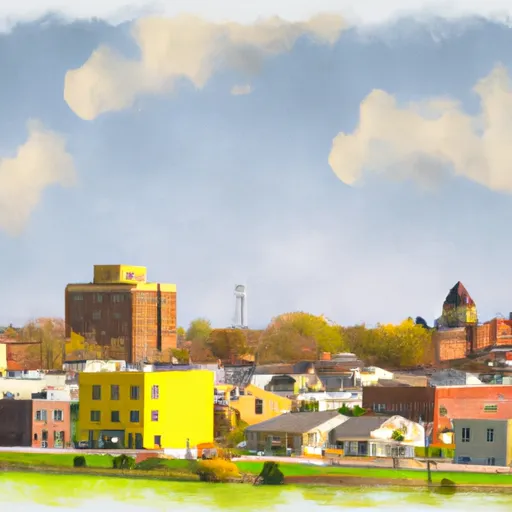-
 Snoflo Premium
Snoflo Premium
Get unlimited access to all our content
With no Ad interruptions! - Start Your Free Trial Login with existing account
Waterloo
Eden Index
Climate
9.1
•
Recreation
3.5
•
Community
2.8
•
Safeguard
5.6/10

Waterloo, Indiana is a small town nestled in the northeastern part of the state. The climate in Waterloo is characterized by four distinct seasons. Summers are warm with average temperatures ranging from the mid-70s to low 80s Fahrenheit, while winters are cold with temperatures dropping to the mid-20s. Spring and fall offer mild weather, making them the perfect times to explore outdoor activities.
Hydrology constituents in Waterloo primarily revolve around its proximity to the St. Joseph River and several nearby lakes, such as Lake George and Lake Everett. These water bodies provide opportunities for boating, fishing, and other water-related activities. The St. Joseph River is known for its scenic beauty, making it an ideal spot for canoeing and kayaking.
Outdoor recreation enthusiasts will find plenty to do in Waterloo. The town is surrounded by picturesque natural areas like the Cedar Creek Wildlife Project, which offers hiking trails and opportunities for wildlife viewing. Nearby Pokagon State Park provides year-round recreational activities, including camping, swimming, and hiking. Waterloo is also home to several parks and green spaces, offering residents and visitors ample opportunities for picnicking, sports, and leisurely walks.
What is the Eden Index?
The Snoflo Eden Index serves as a comprehensive rating system for regions, evaluating their desirability through a holistic assessment of climate health, outdoor recreation opportunities, and natural disaster risk, acknowledging the profound impact of these factors on livability and well-being.
Climate Health Indicator (CHI): 9.1
Waterloo receives approximately
971mm of rain per year,
with humidity levels near 79%
and air temperatures averaging around
10°C.
Waterloo has a plant hardyness factor of
5, meaning
plants and agriculture in this region thrive during a short period during spring and early summer. Most
plants will die off during the colder winter months.
By considering the ideal temperature range, reliable water supplies, clean air, and stable seasonal rain or snowpacks, the Climate Health Indicator (CHI) underscores the significance of a healthy climate as the foundation for quality living.
A healthy climate is paramount for ensuring a high quality of life and livability in a region, fostering both physical well-being and environmental harmony. This can be characterized by ideal temperatures, reliable access to water supplies, clean air, and consistent seasonal rain or snowpacks.
Weather Forecast
Streamflow Conditions
Western Lake Erie
Area Rivers
Western Lake Erie
Snowpack Depths
Western Lake Erie
Reservoir Storage Capacity
Western Lake Erie
Groundwater Levels
Recreational Opportunity Index (ROI): 3.5
The Recreational Opportunity Index (ROI) recognizes the value of outdoor recreational options, such as parks, hiking trails, camping sites, and fishing spots, while acknowledging that climate plays a pivotal role in ensuring the comfort and consistency of these experiences.
Access to outdoor recreational opportunities, encompassing activities such as parks, hiking, camping, and fishing, is crucial for overall well-being, and the climate plays a pivotal role in enabling and enhancing these experiences, ensuring that individuals can engage in nature-based activities comfortably and consistently.
Camping Areas
| Campground | Campsites | Reservations | Toilets | Showers | Elevation |
|---|---|---|---|---|---|
| Ouabache State Park | 125 | 822 ft | |||
| Steuben County Park | None | 1,019 ft | |||
| Versailles State Park | 225 | 965 ft | |||
| Mounds State Rec Area - Brookville Lake | 450 | 945 ft | |||
| Johnny Appleseed Park | 40 | 759 ft | |||
| Governor Bebb Preserve | None | 729 ft | |||
| Pokagon State Park | 275 | 1,026 ft | |||
| Franklin County Park | None | 662 ft | |||
| Brookville Lake | 465 | 694 ft | |||
| Quakertown State Rec Area - Brookville Lake | 450 | 762 ft |
Nearby Ski Areas
Catastrophe Safeguard Index (CSI):
The Catastrophe Safeguard Index (CSI) recognizes that natural disaster risk, encompassing floods, fires, hurricanes, and tornadoes, can drastically affect safety and the overall appeal of an area.
The level of natural disaster risk in a region significantly affects safety and the overall livability, with climate change amplifying these risks by potentially increasing the frequency and intensity of events like floods, fires, hurricanes, and tornadoes, thereby posing substantial challenges to community resilience and well-being.
Community Resilience Indicator (CRI): 2.8
The Community Resilience Indicator (CRI) recognizes that education, healthcare, and socioeconomics are crucial to the well-being of a region. The CRI acknowledges the profound impact of these elements on residents' overall quality of life. By evaluating educational resources, healthcare accessibility, and economic inclusivity, the index captures the essential aspects that contribute to a thriving community, fostering resident satisfaction, equity, and social cohesion.

